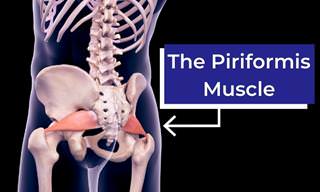1. Epley maneuver
The Epley maneuver is one of the most popular and effective exercises for vertigo, especially in those cases when an episode is triggered by certain head positions or movements. You can do this exercise on both sides, or choose only the side that concerns you.
For example, if you have BPPV on the right side, follow the steps only on one side. If you’re not sure which side is affected, lie down on one side a roll-over. The side you were lying on that caused you to feel dizzier while rolling over is the one that needs treatment. If you can't determine the side, you can treat them both.
We will demonstrate the steps of the exercise for the right side only, so reverse the direction for the left side. Follow these movements and view the video guide above to do the Epley maneuver correctly:
1. Start by sitting upright on a bed. Previously, place a folded blanket or pillow behind you, so that it’s at the level of your shoulder blades when you lay down.
2. Sit up straight and turn your head about 45 degrees to the right, and lie down, resting your shoulders on the pillow or blanket. Hold this position for 30 seconds.
3. Now turn the head 90 degrees to the left and hold for another 30 seconds. Avoid lifting your torso up.
4. Turn your entire body, including the torso and head 90 degrees more to the left. Stay in this position for 30 seconds. Lastly, simply sit up without turning back to the right.
You may experience relief from dizziness right away, but some may need to repeat the maneuver up to 3 times before experiencing results.
Related Article: 9 Reasons You're Feeling Dizzy
2. Foster maneuver
This is one of the easiest exercises to relieve vertigo caused by BPPV, as it requires no extra equipment or help from others. Also known as the half somersault, the Foster maneuver is safe to do at home, but keep in mind that any of these exercises may make you feel dizzy in the process, so be very careful and clear your surroundings from sharp objects or tripping hazards before doing them.
As in the previous exercise, we demonstrate the steps for the right side, and you’ll need to reverse to complete on the other side. Follow these movements and view the video guide above to do the Foster maneuver correctly:
1. Kneel down, placing the hands on the floor. First, raise your chin and move your head up and back. Wait for the dizziness to pass or for 30 seconds.
2. Move your head forward, placing the forehead on the floor, bringing the chin to the neck.
3. Turn the head 45 degrees to the right in the direction of the right elbow. Hold this position for 30 seconds.
4. Without moving your head, raise the head to the level of your back and wait for the spinning to subside, or 30 seconds.
5. Without moving your head, sit up.
After completing the exercise, you may feel better right away, but some may need to repeat the maneuver 4-5 times to feel the effect. It is recommended to wait for 15 in-between repetitions to avoid falls or injuries.
3. Brandt-Daroff Exercises
Like the previous exercise, the Brandt-Daroff Exercises are using gravity to dislodge and move any particles stuck in the inner ear. It’s a simple exercise because it doesn’t require you to know which ear is affected. Follow these movements and view the video guide above to do the Brandt-Daroff Exercises correctly:
1. Sit in the middle of a bed or couch. Lie down on your right side, simultaneously turning the head to look up. Keep looking up for half a minute.
2. Sit up and wait another 30 seconds, then repeat the same steps on the other side.
The entire exercise needs to be repeated 5 times on each side in total. You will most likely feel dizzy after completing these exercises, so make sure to wait for the dizziness to go away before standing up.
4. Semont maneuver
The Semont maneuver is the last exercise we will show you in this article. This exercise is also known as the liberatory maneuver, and it takes little time. That said, the classic version of this exercise does require assistance from another person, preferably that of a physical therapist or doctor, since it involves moving the patient quickly from one side to the other.
There is also a simplified version of the exercise shown in the video above and explained below. This is how it works:
1. Start by sitting up at the edge of a bed or couch, then tilt the head 45 degrees away from the affected side.
2. Quickly lie down on the affected side, your head should be looking up.
3. If this position makes you dizzy, wait for it to pass. Then, rapidly move to the other side without moving your head. You will now be looking down.
3. If this triggers vertigo, stay in that position until it stops, and then sit back up.
Usually, this exercise will make your vertigo go away after a day or two, and it’s only necessary to do it once. After completing any of these exercises, it is recommended to stay in an upright position for a few hours. For better results, it’s also recommended to sleep on your back propped up with several pillows to stay as possible to being upright as possible throughout the night.
To prevent the issue from coming back, we recommend trying some of the home remedies we mentioned in a previous article titled Suffer From Dizziness? These Home Remedies Will Help. Also, if the dizziness or vertigo persists for days or weeks, and none of the exercises or other methods you try work, we strongly recommend consulting your healthcare provider for further assistance.
Share these exercises with those who will find them useful!
 Go to BabaMail
Go to BabaMail





















































